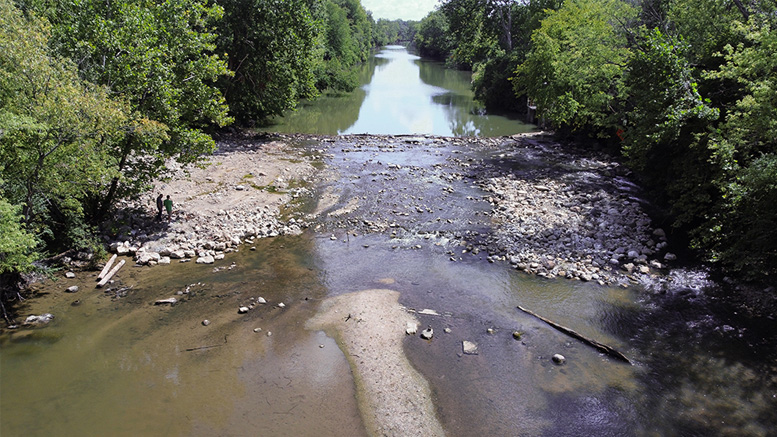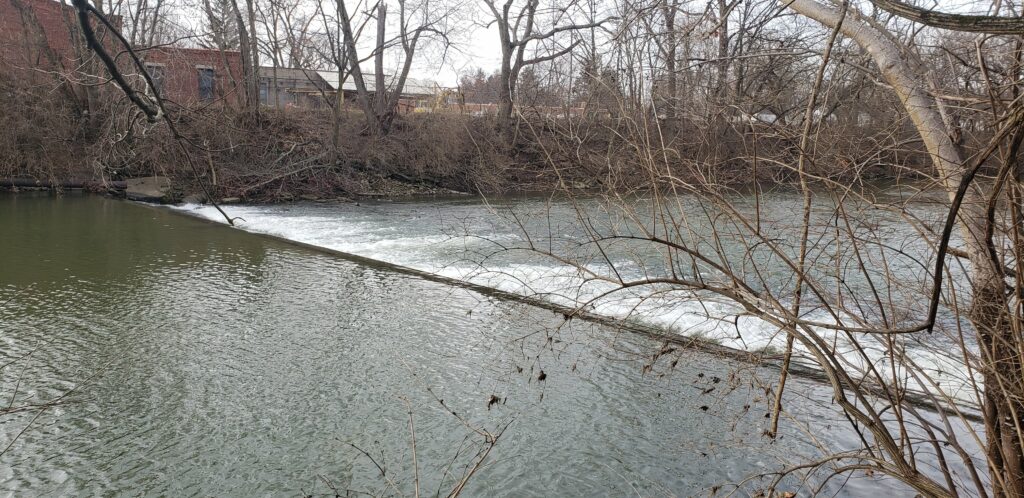By Phil Tevis, David Heilman, and Toria Callow—
DELAWARE COUNTY, IN—The Delaware County Soil and Water Conversation District received grant funding from the U.S. Fish and Wildlife Service (USFWS), Indiana Department of Natural Resources and the Ed and Virginia Ball Foundation to modify the water intake dam at the Indiana American Water Company filtration facility located on Burlington Avenue in Muncie.
“The Muncie dams have been identified in many studies since the 1990’s as an opportunity to make these types of modifications to improve our local water quality, fisheries and public safety for recreational uses,” stated Erik Fisher Chairman of the Delaware County Soil and Water Conservation District.
“The Indiana American Water Company dam in Muncie is a truly unique approach to dam removals statewide” said Doug Nusbaum of the Lake and River Enhancement Program at the Indiana Department of Natural Resources. “There are times when dam removal is not an option. This dam is one of those instances since the water company still needs it to provide adequate water levels at its White River intake.”
Indiana American Water uses both surface water and groundwater sources at its water treatment facility in Muncie. Over the last several years, the company has invested approximately $37 million to enhance its water treatment facilities and make repairs and improvements at the Prairie Creek Reservoir located upstream from the water treatment plant. FlatLand Resources, of Muncie, designed and installed a riffle directly downstream of the dam in July of 2022. This modification allowed the dam to remain in place to divert water for drinking, while also enhancing water quality, stream biodiversity, stream safety and providing passage for recreational uses of the river.
“The USFWS funding is specifically tied to increasing fish passage on rivers in the Ohio River basin,” explained Kevin Haupt of the USFWS. “The Muncie water company dam provided the USFWS a unique opportunity to study a species of very small darter fish and their ability to swim through the constructed riffle. This study would not be possible without the 50-plus years of fish data the Muncie Bureau of Water Quality has collected. Muncie is very fortunate to have what might be the longest water quality fisheries studies in the country due to the Muncie Bureau of Water Quality.”
The Muncie Bureau of Water Quality (BWQ) is injecting a harmless tracing tag into the darters. This pliable colored elastomer allows the Bureau’s biologists to follow the fish to determine if they can swim through the newly constructed riffle to habitats previously unreachable due to the dam.
Rick Conrad, Director of the Muncie Bureau of Water Quality explained that the Bureau biologists have seen big changes in the fisheries where Muncie already removed two dams a few years ago. “We have documented increased movements of Smallmouth Bass since the other Muncie dams have been removed. We anticipate something similar with the modification of this dam and are eager to follow the darters upstream. The information collected will add to the knowledge used by USFWS and others as they explore dam removal options elsewhere.”
“Muncie once had five-dams that all served critical industrial needs during the industrial expansion of our town. The High Street dam is the only remaining dam that has not been modified in the area,” Explained Erik Fisher. “A study is currently underway to determine if the dam can be removed or altered in a similar manner as the Indiana American Water dam.”
One example of a species affected by an unmodified dam structure is the American Eel, which begins its life cycle in the middle of the Atlantic Ocean and travels upstream in freshwater rivers until maturity when it will then return to the ocean to reproduce. A few years ago, the BWQ documented that the American Eels were being blocked in their remarkable journey up the White River by the 9-foot tall High Street dam.
While much progress has been made, there is still more to do. Muncie is proud to lead the way in dam removals and modifications within the state of Indiana. The removal of the Muncie dams has helped the Eels, darters, freshwater mussels and people with better and safer passage along the river. It is the hope that others can follow this example and help improve waterways around the state for both fish and recreationalists.




